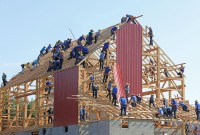- Home
- Business Processes
- Industry Knowledge
- Aerospace Industry
- Automotive Industry
- Banking Domain
- BFSI Industry
- Consumer/ FMCG Industry
- Chemicals Industry
- Engineering & Construction
- Energy Industry
- Education Domain
- Finance Domain
- Hospitality Domain
- Healthcare Industry
- Insurance Domain
- Retail Industry
- Travel and Tourism Domain
- Telecom Industry
- Leadership Skills
- eLearning
- Home
- Leadership
- Leadership & Management
- Definition of Leadership
Definition of Leadership
Leadership has been defined in different ways by different sets of scholars. In very simple terms leadership can be defined as the skill of a person to influence an individual or a group for achievement of a goal in a given situation. One can use different dimensions and perspectives to define leadership. Through the evolution of leadership thought, leadership has been defined in various ways discussed here.
“A leader is one who has followers”; is a too simple a definition and this description does not clearly define what other attributes are associated with leadership. One can use different dimensions and perspectives to define leadership. Through the evolution of leadership thought, leadership has been defined in various ways with following perspectives:
- Group Processes
- Personality Perspective
- Behavioral Traits
- Power Relationships
- Process perspective
- Skills perspective
Definitions of Leadership
According to MacIver and Page Leadership is the capacity to persuade or to direct man that comes from personal qualities apart from office. It indicates the difference between leadership and office. An individual does not become a leader only by occupying an office which carries responsibility. It is a matter of secondary importance that his important office is of assistance to him in his endeavor to become a leader.
According to Philip A. Woods (2005) leadership is not just a set of free-standing actions i.e., it is not a linear process flowing from leader to the follower but it is a collective entity which comprises of the impetus and direction that emerges from the group which is more than the sum of its parts (the individuals) who make up a group or organization. .
Warren Bennis’ definition of leadership is focused much more on the individual capability of the leader. He defined leadership as a function of knowing oneself, having a vision that is well communicated, building trust among colleagues, and taking effective action to realize one’s own leadership potential.
Leadership can also be called the catalyst that transforms potential into reality. The concept of leadership in itself covers all interpersonal relationships that influence the working of' the organization towards achieving its business objectives and growth.
Leadership is the art of influencing others to direct their will, abilities and efforts to the achievement of leader’s goals. In the context of organizations, leadership lies in influencing individual and group effort toward the optimum achievement of organizational objectives.
Keith Davis observes that, “without leadership, an organization is but a muddle of men and machines…Leadership transforms potential into reality. It is the ultimate act which brings to success all the potential that is in an organization and its people”.
Leadership is often defined as the art of influencing others (people) to strive willingly; to do what the leader wants them to do (often to do the mutually compatible objectives) with zeal and confidence.
According to Dayal (1999) leadership is development of people, not the task. A leader creates conditions for the development of individuality and enhancement of inherent capability of individuals.
The leader is the inspiration and director of the action. He is the person in the group that possesses the combination of personality and leadership skills that makes others want to follow his direction.
Leadership focuses on “people” aspect of management and is based on the assumption that organizational effectiveness significantly depends on their motivation, effort and abilities.
According to Pigors, “Leadership is a process of control in which by the assumption of superiority a person or group regulates the activities of others for purposes of his own choosing.”
In 1938, Chester Bernard gave a new definition of leadership and stated that, “leadership is the ability of a superior to influence the behaviour of subordinates and persuade them to follow a particular course of action”.
A recent theorist on leadership, Williams (2005), states that, “leadership is an interactive art in which the leader is dancing with the context, the problem, the faction, and the objective”.
It is encouraging and inspiring individuals and teams to give their best to achieve a desired result.
Leadership is an attribute of the person who is an ideal for the other members of the group.
Leadership is the behavior that affects the behavior of other people, more than their behavior affects that of the leader.
Leaders work with and through people to accomplish goals.
In the 21 Irrefutable Laws of Leadership, John Maxwell sums up his definition of leadership as “leadership is influence - nothing more, nothing less.”
Anyone who acts as a model to others is often called a “leader”.
Leader leads, suggests, orders, and also guides. Other people follow him. We can say that leadership and domination are not the same meaning.
Peter Drucker defined a leader as someone who has followers.
What is the best definition of leadership?
It is difficult to qualitatively define leadership. Leadership involves various dimensions and attributes. A simple definition of leadership is that leadership is the art of motivating a group of people to act towards achieving a common goal. It is a psychological process of providing guidance for followers. To lead is to guide, conduct, direct, and proceed.
Related Links
You May Also Like
-
Teams are part of the modern organizational culture. Whether you are a team leader or a team member, having a better understanding of how teams work, and being able to identify where the team is in the process, is a critical part of ensuring the team is ultimately successful. Start with the basics and understand what a team is and what role they play in an organization.
-
At different points in your professional career, it is helpful to identify your core values. Values are the qualities considered to be the most important guiding principles that determine the priorities in your life and greatly influence your career choices. Your career brings happiness when it is in agreement with the beliefs you have about what is important and meaningful to you. Awareness of your values will help you develop a clearer sense of what's most important to you in life.
-
What are the functions which a leader does to establish as a leader? What are the activities undertaken by them to become great leaders, rather revolutionary leaders? The most important tasks done by a leader in all situations are defining the vision, mission, and goals, leading the team, administrative functions, motivating followers, decision making and conflict resolution, and continuous development.
-
Power is the ability to exercise influence or control over others. Leadership involves authority and it is very important for leaders to understand what type of power they're using. The 5 Types of Power in Leadership are Coercive power, expert power, legitimate power, referent power, and reward power. Authority is the right to command and extract obedience from others. It comes from the organization and it allows the leader to use power.
-
Taylor’s Scientific Management
Taylor’s theory of scientific management aimed at improving economic efficiency and labor productivity. Taylor had a simple view that money motivated people at work. He felt that workers should get a fair day's pay for a fair day's work, and that pay should be linked to the amount produced. He introduced the differential piece rate system, of paying wages to the workers.
-
In this study of power, Raven identified five bases of power as coercive, reward, legitimate, referent, and expert. The 5 Types of Power can help you decide when it is appropriate to use a particular type of power in important situations. Leadership involves authority and it is very important for leaders to understand what type of power they're using.
-
Tools for Developing Your Team
If a manager has too many weak spots in the talent of the team, the ability to empower the team members to independently execute the project is impaired. Assignments fall behind schedule or stretch out because the needed skills or knowledge are not in place when needed. To successfully execute important projects, hiring talented people, and increasing the talents of existing staff are most important.
-
Theory Z also called the "Japanese Management" style is a leadership theory of human motivation focused on organizational behavior, communication, and development. It assumes that employees want to enter into long term partnerships with their employers and peers. Offering stable jobs with an associated focus on the well-being of employees results in increased employee loyalty to the company.
-
Thinking & Problem Solving Skills
Today's dynamic business world demands that you make decisions that significantly boost productivity and drive competitive advantage. But how do you know whether a decision will benefit the organization? And how do you know that the decisions are based on rational and statistical reasoning? Explore how to become a dynamic problem solver with the skills to make accurate decisions.
-
There are four characteristics of leadership that help us to understand the character of leadership as a concept. 1. Leadership is a process, 2. Leadership involves influence, 3. Leadership always occurs in a group context and 4. Leadership involves goal attainment. These are the four components that make up the character of the 'leadership' term and help us to define the leadership concept. All of these components of leadership have common characteristics.
Explore Our Free Training Articles or
Sign Up to Start With Our eLearning Courses

About Us
Learning
© 2023 TechnoFunc, All Rights Reserved










